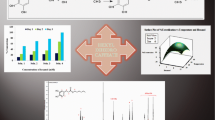Abstract
Lipase-catalyzed caffeic acid phenethyl ester (CAPE) synthesis in ionic liquid, 1-ethyl-3-methylimidazolium bis[(trifluoromethyl)sulfonyl]imide ([Emim][Tf2N]), was investigated in this study. The effects of several reaction conditions, including reaction time, reaction temperature, substrate molar ratio of phenethyl alcohol to caffeic acid (CA), and weight ratio of enzyme to CA, on CAPE yield were examined. In a single parameter study, the highest CAPE yield in [Emim][Tf2N] was obtained at 70 °C with a substrate molar ratio of 30:1 and weight ratio of enzyme to CA of 15:1. Based on these results, response surface methodology (RSM) with a 3-level-4-factor central composite rotatable design (CCRD) was adopted to evaluate enzymatic synthesis of CAPE in [Emim][Tf2N]. The four major factors were reaction time (36–60 h), reaction temperature (65–75 °C), substrate molar ratio of phenethyl alcohol to CA (20:1–40:1), and weight ratio of enzyme to CA (10:1–20:1). A quadratic equation model was used to analyze the experimental data at a 95 % confidence level (p < 0.05). A maximum conversion yield of 99.8 % was obtained under the optimized reaction conditions [60 h, 73.7 °C, substrate molar ratio of phenethyl alcohol to CA (27.1:1), and weight ratio of enzyme to CA (17.8:1)] established by our statistical method, whereas the experimental conversion yield was 96.6 ± 2 %.






Similar content being viewed by others
References
Altuğ ME, Serarslan Y, Bal R, Kontaş T, Ekici F, Melek IM, Aslan H, Duman T (2008) Caffeic acid phenethyl ester protects rabbit brains against permanent focal ischemia by antioxidant action: a biochemical and planimetric study. Brain Res 1201:135–142
Coban S, Yildiz F, Terzi A, Al B, Ozgor D, Ara C, Polat A, Esrefoglu M (2010) The effect of caffeic acid phenethyl ester (CAPE) against cholestatic liver injury in rats. J Surg Res 159:674–679
Widjaja A, Yeh T-H, Ju Y-H (2008) Enzymatic synthesis of caffeic acid phenethyl ester. J Chin Inst Chem Eng 39:413–418
Parvulescu VI, Hardacre C (2007) Catalysis in ionic liquids. Chem Rev 107:2615–2665
Moniruzzaman M, Nakashima K, Kamiya N, Goto M (2010) Recent advances of enzymatic reactions in ionic liquids. Biochem Eng J 48:295–314
Ha SH, Menchavez RN, Koo Y-M (2010) Reprocessing of spent nuclear waste using ionic liquids. Korean J Chem Eng 27:1360–1365
Swatloski RP, Spear SK, Holbrey JD, Rogers RD (2002) Dissolution of cellulose with ionic liquids. J Am Chem Soc 124:4974–4975
Ha SH, Mai NL, An G, Koo Y-M (2011) Microwave-assisted pretreatment of cellulose in ionic liquid for accelerated enzymatic hydrolysis. Bioresour Technol 102:1214–1219
Zhao H (2006) Innovative applications of ionic liquids as green engineering liquids. Chem Eng Commun 193:1660–1677
Ha SH, Lee SH, Dang DT, Kwon MS, Chang W-J, Yu YJ, Byun IS, Koo Y-M (2008) Enhanced stability of Candida antarctica lipase B in ionic liquids. Korean J Chem Eng 25:291–294
van Rantwijk F, Sheldon RA (2007) Biocatalysis in ionic liquids. Chem Rev 107:2757–2785
Bas D, Boyac IH (2007) Modeling and optimization I: usability of response surface methodology. J Food Eng 78:836–845
Hanrahan G, Lu K (2006) Application of factorial and response surface methodology in modern experimental design and optimization. Crit Rev Anal Chem 36:141–151
Ha SH, Anh TV, Lee SH, Koo Y-M (2012) Effect of ionic liquids on enzymatic synthesis of caffeic acid phenethyl ester. Bioprocess Biosyst Eng 35:235–240
Angelopoulos P, Evangelaras H, Koukouvinos C (2009) Small, balanced, efficient and near rotatable central composite designs. J Stat Plan Inf 139:2010–2013
Chen H-C, Ju H-Y, Twu Y-K, Chen J-H, Chang CJ, Liu Y-C, Chang C, Shieh C-J (2010) Optimization of enzymatic synthesis of caffeic acid phenethyl ester by RSM. New Biotechnol 27:89–93
Radzi SM, Basri M, Salleh AB, Ariff AM, Rosfarizan R (2005) High performance enzymatic synthesis of oleyl oleate using immobilized lipase from Candida antarctica. Electron J Biotechnol 8:291–298
Villeneuve P, Barea B, Sarrazin P, Davrieux F, Boulanger R, Caro Y (2003) Synthesis of pyroglutamic acid fatty esters though lipase-catalysed esterification with medium chains alcohols. Enzym Microb Technol 33:79–84
Lee SH, Koo Y-M, Ha SH (2008) Influence of ionic liquids under controlled water activity and low halide content on lipase activity. Korean J Chem Eng 25:1456–1462
Madeira Lau R, Sorgedrager MJ, Carrea G, van Rantwijk F, Secundo F, Sheldon RA (2004) Dissolution of Candida antarctica lipase B in ionic liquids: effects on structure and activity. Green Chem 6:483–487
Amin NAS, Anggoro DD (2004) Optimization of direct conversion of methane to liquid fuels over Cu loaded W/ZSM-5 catalyst. Fuel 83:487–494
Imandi SB, Bandaru VR, Somalanka SR, Garapati HR (2007) Optimization of medium constituents for the production of citric acid from by product glycerol using Doehlert experimental design. Enzym Microb Technol 40:1367–1372
Acknowledgments
This work was supported by the 2012 Hannam University Research Fund.
Author information
Authors and Affiliations
Corresponding authors
Rights and permissions
About this article
Cite this article
Ha, S.H., Van Anh, T. & Koo, YM. Optimization of lipase-catalyzed synthesis of caffeic acid phenethyl ester in ionic liquids by response surface methodology. Bioprocess Biosyst Eng 36, 799–807 (2013). https://doi.org/10.1007/s00449-013-0906-6
Received:
Accepted:
Published:
Issue Date:
DOI: https://doi.org/10.1007/s00449-013-0906-6




